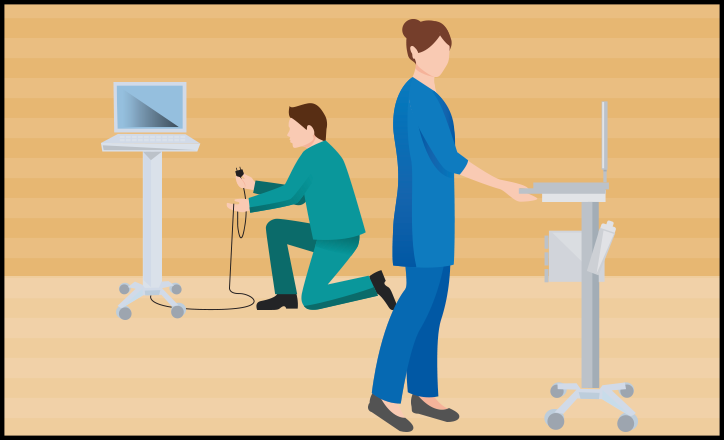
Corded vs Cordless Workstations (pt 5): Factors to Consider
This is our final installment of our five-part blog series on the reasons why cordless EHR workstations are a better fit for nurses than those that must be plugged in to charge. Read our overview in part one; our analysis of flexibility, efficiency, and convenience in part two; our discussion of availability, battery charge, and budget in part three; and our assessment of durability and safety in part four. For part five, we delve into ergonomics and space considerations.
Ergonomics
Consider the already physically demanding job nurses have. They walk thousands of steps daily during their shifts and they lift and support the patients they care for. Their equipment should be as ergonomic and as light as possible, so they can save their energy and focus for patients.
Corded EHR workstations house a heavy internal battery and require more physical demand from nurses, bending, stooping, reaching and twisting to plug and unplug them, often multiple times per shift. Over time, the physical strain spent accessing hard to reach outlets can add up and wreak havoc on a nurse’s body. Whereas, cordless EHR workstations, use light weight swappable battery technology, making it almost effortless, with a quick 6 second battery swap, to power through a shift.
MobiusPower® batteries on cordless solutions slide into an easy-to-reach holster at the back of the workstation. Nurses swap them from a wall-mounted charging bay located at hip height. Whether in the charging bay or the workstation’s holster, the battery handle is always at a nurse’s fingertips. By decreasing physical effort, MobiusPower swappable batteries and cordless EHR workstations help nurses do their jobs comfortably, safely, and efficiently.
MobiusPower® swappable batteries are lightweight. The Enovate Encore workstation with MobiusPower is 50% lighter than a typical corded solution, which houses a bulky, heavy internal battery.
Space
The use of cordless EHR workstations require less floor space. In part 3, we discussed how a hospital can run on fewer EHR workstations because there is no down time for recharging. Cordless EHR workstations using swappable battery power never sit idle; they aren’t taking up floor space or monopolizing outlets to charge, they’re constantly in use.
With the MobiusPower system, several batteries charge in a wall-mounted charging bay that has a dedicated outlet. Batteries are not tied to a specific workstation, so a nurse can grab any battery as needed from any charging bay and place it in a workstation’s holster. Likewise, they can replace a depleted battery in any available charger. The bays are strategically located in easy-to-access areas.
When using corded solutions, a nurse must locate an outlet to charge the workstation, but the outlets are often inconveniently located in hard to reach cramped areas. As a result, EHR workstations often sit idle in awkward spots, degrading efficiency and creating safety concerns. The MobiusPower system was designed to eliminate these issues.
At Enovate Medical, we take time with our clients, working directly with nurses and IT professionals, to conduct a thorough clinical device assessment (CDA). In doing so, our clients have lowered their overall capital outlay and reduced their operational expenses. Most importantly, they’ve achieved enhanced nursing workflow and therefore an improved patient experience.
Call today for a comprehensive clinical device assessment.

